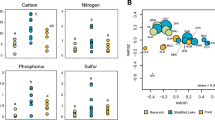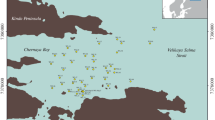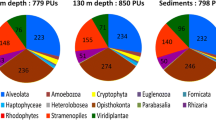Abstract
Recent culture-independent surveys of eukaryotic small-subunit ribosomal DNA (SSU rDNA) from many environments have unveiled unexpectedly high diversity of microbial eukaryotes (microeukaryotes) at various taxonomic levels. However, such surveys were most probably biased by various technical difficulties, resulting in underestimation of microeukaryotic diversity. In the present study on oxygen-depleted sediment from a deep-sea methane cold seep of Sagami Bay, Japan, we surveyed the diversity of eukaryotic rDNA in raw sediment samples and in two enrichment cultures. More than half of all clones recovered from the raw sediment samples were of the basidiomycetous fungus Cryptococcus curvatus. Among other clones, phylotypes of eukaryotic parasites, such as Apicomplexa, Ichthyosporea, and Phytomyxea, were identified. On the other hand, we observed a marked difference in phylotype composition in the enrichment samples. Several phylotypes belonging to heterotrophic stramenopiles were frequently found in one enrichment culture, while a phylotype of Excavata previously detected at a deep-sea hydrothermal vent dominated the other. We successfully established a clonal culture of this excavate flagellate. Since these phylotypes were not identified in the raw sediment samples, the approach incorporating a cultivation step successfully found at least a fraction of the “hidden” microeukaryotic diversity in the environment examined.








Similar content being viewed by others
References
Amaral Zettler LA, Gómez F, Zettler E, Keenan BG, Amils R, Sogin ML (2002) Eukaryotic diversity in Spain’s River of Fire. Nature 417:137
Atkins MS, Anderson OR, Wirsen CO (1998) Effect of hydrostatic pressure on the growth rates and encystment of flagellated protozoa isolated from a deep-sea hydrothermal vent and a deep shelf region. Mar Ecol Prog Ser 171:85–95
Atkins MS, Teske AP, Anderson OR (2000) A survey of flagellate diversity at four deep-sea hydrothermal vents in the Eastern Pacific Ocean using structural and molecular approaches. J Eukaryot Microbiol 47:400–411
Behnke A, Bunge J, Barger K, Breiner HW, Alla V, Stoeck T (2006) Microeukaryote community patterns along an O2/H2S gradient in a supersulfidic anoxic fjord (Framvaren, Norway). Appl Environ Microbiol 72:3626–3636
Bernard C, Simpson AGB, Patterson DJ (2000) Some free-living flagellates (protista) from anoxic habitats. Ophelia 52:113–142
Berney C, Fahrni J, Pawlowski J (2004) How many novel eukaryotic ‘kingdoms’? Pitfalls and limitations of environmental DNA surveys. BMC Biol 2:13
Countway PD, Gast RJ, Savai P, Caron DA (2005) Protistan diversity estimates based on 18S rDNA from seawater incubations in the Western North Atlantic. J Eukaryot Microbiol 52:95–106
Dawson SC, Pace NR (2002) Novel kingdom-level eukaryotic diversity in anoxic environments. Proc Natl Acad Sci USA 99:8324–8329
Díez B, Pedrós-Alió C, Massana R (2001) Study of genetic diversity of eukaryotic picoplankton in different oceanic regions by small-subunit rRNA gene cloning and sequencing. Appl Environ Microbiol 67:2932–2941
Drebes G, Kühn SF, Gmelch A, Schnepf E (1996) Cryothecomonas aestivalis sp. nov., a colourless nanoflagellate feeding on the marine centric diatom Guinardia delicatula (Cleve) Hasle. Helgol Wiss Meeresunters 50:497–515
Dromer F, Moulignier A, Dupont B, Gueho E, Baudrimont M, Improvisi L, Provost F, Gonzalez-Canali G (1995) Myeloradiculitis due to Cryptococcus curvatus in AIDS. AIDS 9:395–396
Dumitru R, Hornby JM, Nickerson KW (2004) Defined anaerobic growth medium for studying Candida albicans basic biology and resistance to eight antifungal drugs. Antimicrob Agents Chemother 48:2350–2354
Edgcomb VP, Kysela DT, Teske A, de Vera Gomez A, Sogin ML (2002) Benthic eukaryotic diversity in the Guaymas Basin hydrothermal vent environment. Proc Natl Acad Sci USA 99:7658–7662
Ekebom J, Patterson DJ, Vørs N (1995/96) Heterotrophic flagellates from coral reef sediments (Great Barrier Reef, Australia). Arch Protistenkd 146:251–272
Ekelund F, Patterson DJ (1997) Some heterotrophic flagellates from a cultivated garden soil in Australia. Arch Protistenkd 148:461–478
Fenchel T, Finlay BJ (1995) Ecology and evolution in anoxic worlds. Oxford University Press, Oxford
Guindon S, Gascuel O (2003) Simple, fast, and accurate algorithm to estimate large phylogenies by maximum likelihood. Syst Biol 52:696–704
Hoppenrath M, Leander BS (2006) Ebriid phylogeny and the expansion of the Cercozoa. Protist 157:279–290
Hugenholtzt P, Huber T (2003) Chimeric 16S rDNA sequences of diverse origin are accumulating in the public databases. Int J Syst Evol Microbiol 53:289–293
Ikemoto E, Kyo M (1993) Development of microbiological compact mud sampler (in Japanese with English abstract). JAMSTEC Res 30:1–16
Kim YW, Yasuda M, Yamagishi A, Oshima T, Ohta S (1995) Characterization of the endosymbiont of a deep-sea bivalve, Calyptogena soyoae. Appl Environ Microbiol 61:823–827
Kühn S, Drebes G, Schnepf E (1996) Five species of the nanoflagellate Pirsonia in the German Bight, North Sea, feeding on planktic diatoms. Helgol Wiss Meeresunters 50:205–222
Kühn SF, Medlin LK, Eller G (2004) Phylogenetic position of the parasitoid nanoflagellate Pirsonia inferred from nuclear-encoded small subunit ribosomal DNA and a description of Pseudopirsonia n. gen. and Pseudopirsonia mucosa (Drebes) comb. nov. Protist 155:143–156
Leander BS, Harper JT, Keeling PJ (2003) Molecular phylogeny and surface morphology of marine aseptate gregarines (Apicomplexa): Selenidium spp. and Lecudina spp. J Parasitol 89:1191–1205
Leander BS, Lloyd SAJ, Marshall W, Landers SC (2006) Phylogeny of marine gregarines (Apicomplexa)—Pterospora, Lithocystis and Lankesteria—and the origin(s) of coelomic parasitism. Protist 157:45–60
López-García P, Rodriguez-Valera F, Pedros-Alio C, Moreira D (2001) Unexpected diversity of small eukaryotes in deep-sea Antarctic plankton. Nature 409:603–607
López-García P, Philippe H, Gail F, Moreira D (2003) Autochthonous eukaryotic diversity in hydrothermal sediment and experimental microcolonizers at the Mid-Atlantic Ridge. Proc Natl Acad Sci USA 100:697–702
Maidak BL, Cole JR, Lilburn TG, Parker CT Jr, Saxman PR, Farris RJ, Garrity GM, Olsen GJ, Schmidt TM, Tiedje JM (2001) The RDP-II (Ribosomal Database Project). Nucl Acids Res 29:173–174
Massana R, Balagué V, Guillou L, Pedrós- Alió C (2004a) Picoeukaryotic diversity in an oligotrophic coastal site studied by molecular and culturing approaches. FEMS Microbiol Ecol 50:231–243
Massana R, Castresana J, Balagué V, Guillou L, Romari K, Groisillier A, Valentin K, Pedrós-Alió C (2004b) Phylogenetic and ecological analysis of novel marine stramenopiles. Appl Environ Microbiol 70:3528–3534
Mendoza L, Taylor JW, Ajello L (2002) The class mesomycetozoea: a heterogeneous group of microorganisms at the animal–fungal boundary. Annu Rev Microbiol 56:315–344
Moon-van der Staay SY, De Wachter R, Vaulot D (2001) Oceanic 18S rDNA sequences from picoplankton reveal unsuspected eukaryotic diversity. Nature 409:607–610
Moreira D, López-García P (2003) Are hydrothermal vents oases for parasitic protists? Trends Parasitol 19:556–558
Naqvi SWA (1994) Denitrification processes in the Arabian Sea. Proc Indian Acad Sci Earth Planet Sci 103:279–300
Pawlowski J, Bolivar I, Fahrni JF, Cavalier-Smith T, Gouy M (1996) Early origin of foraminifera suggested by SSU rRNA gene sequences. Mol Biol Evol 13:445–450
Perkins FO, Barta JR, Clopton RE, Peirce MA, Upton SJ (2002) Phylum Apicomplexa. In: Lee JJ, Leedale GF, Bradbury P (eds) The illustrated guide to the protozoa. Allen Press, Lawrence, pp 190–304
Raghukumar S (2002) Ecology of the marine protists, the Labyrinthulomycetes (Thraustochytrids and Labyrinthulids). Eur J Protistol 38:127–145
Rodríguez F, Oliver JL, Marin A, Medina JR (1990) The general stochastic model of nucleotide substitution. J Theoret Biol 142:485–501
Ronquist F, Huelsenbeck JP (2003) MrBayes 3: Bayesian phylogenetic inference under mixed models. Bioinformatics 19:1572–1574
Schnepf E, Drebes G, Elbrächter M (1990) Pirsonia guinardiae, gen. et spec. nov.: a parasitic flagellate on the marine diatom Guinardia flaccida with an unusual mode of food uptake. Helgol Wiss Meeresunters 44:275–293
Schnepf E, Kühn SF, Bulman S (2000) Phagomyxa bellerocheae sp. nov. and Phagomyxa odontellae sp. nov., Plasmodiophoromycetes feeding on marine diatoms. Helgoland Mar Res 54:237–241
Schweikert M, Schnepf E (1997) Light and electron microspical observations on Pirsonia punctigerae spec. nov., a nanoflagellate feeding on the marine centric diatom Thalassiosira punctigera. Eur J Protistol 33:168–177
Simpson AGB (2003) Cytoskeletal organization, phylogenetic affinities and systematics in the contentious taxon Excavata (Eukaryota). Int J Syst Evol Microbiol 53:1759–1777
Simpson AGB, Patterson DJ (1999) The ultrastructure of Carpediemonas membranifera (Eukaryota) with reference to the “Excavate hypothesis”. Eur J Protistol 35:353–370
Stoeck T, Epstein S (2003) Novel eukaryotic lineages inferred from small-subunit rRNA analyses of oxygen-depleted marine environments. Appl Environ Microbiol 69:2657–2663
Stoeck T, Taylor GT, Epstein SS (2003) Novel eukaryotes from the permanently anoxic Cariaco Basin (Caribbean Sea). Appl Environ Microbiol 69:5656–5663
Stoeck T, Hayward B, Taylor GT, Varela R, Epstein SS (2006) A multiple PCR-primer approach to access the microeukaryotic diversity in environmental samples. Protist 157:31–43
Takishita K, Miyake H, Kawato M, Maruyama T (2005) Genetic diversity of microbial eukaryotes in anoxic sediment around fumaroles on a submarine caldera floor based on the small-subunit rDNA phylogeny. Extremophiles 9:185–196
Takishita K, Tsuchiya M, Reimer JD, Maruyama T (2006) Molecular evidence demonstrating the basidiomycetous fungus Cryptococcus curvatus is the dominant microbial eukaryote in sediment at the Kuroshima Knoll methane seep. Extremophiles 10:165–169
Takishita K, Tsuchiya M, Kawato M, Oguri K, Kitazato H, Maruyama T (2007) Genetic diversity of microbial eukaryotes in anoxic sediment of the saline meromictic lake Namako-ike (Japan): On the detection of anaerobic or anoxic-tolerant lineages of eukaryotes. Protist 158:51–64
Thompson JD, Higgins DG, Gibson TJ (1994) CLUSTAL W: improving the sensitivity of progressive multiple sequence alignment through sequence weighting, position-specific gap penalties and weight matrix choice. Nucl Acids Res 22:4673–4680
Thomsen HA, Buck KR, Bolt PA, Garrison DL (1991) Fine structure and biology of Cryothecomonas gen. nov. (Protista incertae sedis) from the ice biota. Can J Zool 69:1048–1070
Tillmann U, Hesse KJ, Tillmann A (1999) Large-scale parasitic infection of diatoms in the Northfrisian Wadden Sea. J Sea Res 42:255–261
Tong SM, Nygaard K, Bernard C, Vørs N, Patterson DJ (1998) Heterotrophic flagellates from the water column in Port Jackson, Sydney, Australia. Eur J Protistol 34:162–194
Zuendorf A, Bunge J, Behnke A, Barger K, Stoeck T (2006) Diversity estimates of microeukaryotes below the chemocline of the anoxic Mariager Fjord, Denmark. FEMS Microbiol Ecol 58:476–491
Acknowledgments
We thank Dr. J.D. Reimer (Biological Institute on Kuroshio) for critical reading of the manuscript; Drs. M. Tsuchiya and H. Nomaki (JAMSTEC) for providing unpublished environmental data on the sediments investigated here; Dr. I. Inouye (University of Tsukuba) for valuable advice; and the captain and crew of the R/V Natsushima and the commander, pilots, and operation team of the ROV Hyper-Dolphin for dedicated efforts. This work was supported in part by grants from the Japan Society for the Promotion of Science (No. 17770077 to K. Takishita, No. 18570214 to Y. Inagaki and No. 17370029 to I. Inouye).
Author information
Authors and Affiliations
Corresponding author
Additional information
Communicated by K. Horikoshi.
Electronic supplementary material
Below is the link to the electronic supplementary material.
Rights and permissions
About this article
Cite this article
Takishita, K., Yubuki, N., Kakizoe, N. et al. Diversity of microbial eukaryotes in sediment at a deep-sea methane cold seep: surveys of ribosomal DNA libraries from raw sediment samples and two enrichment cultures. Extremophiles 11, 563–576 (2007). https://doi.org/10.1007/s00792-007-0068-z
Received:
Accepted:
Published:
Issue Date:
DOI: https://doi.org/10.1007/s00792-007-0068-z




